Ask Dr. C – Episode 3- Inversion Traction and Neuropathy

OK, I rarely do three blogs on the same topic in a row, but man you guys are coming up with great questions! Hence, here’s Episode 3. Let’s dig in.
How come when I use an inversion table, my back pain goes away, even after a few minutes, and doesn’t come back for many days?
I love this question because it’s a great way to teach about how the spine works. The answer to this question involves Silly Putty. Why?
Silly Putty, for those that remember it, is the definition of a viscoelastic structure. If you place a book on it and walk away, when you come back it will be flat, but it’s like rubber when you throw it against the wall. This property of deformation when a long duration force is applied is called vicious and being rubber-like when a short duration force is applied is called elastic. Hence a structure that has both properties is called viscoelastic.
The discs in your spine are also viscoelastic. When you sit for any time, this is like placing the book on the Silly Putty and your discs flatten slightly. However, when you walk, your discs are elastic. They easily resist force and act as shock absorbers for your spine bones. However, unlike Silly Putty, in your spine, all of this works through water.
Your spinal discs have water in them that is held there by chemicals called GAGs (glycosaminoglycans). When you walk, that water is moved in and out of the disc and this process is called imbibition. When you sit, that water leaks out of the disc and isn’t replaced. When your discs age, they lose cells that produce those GAGs which hold onto the water. Hence, your discs become more able to flatten. See my video below for more information:
When your discs can’t hold onto water and flatten, the facet joints at that level get overloaded and the disc bulges and irritates nerves, When your discs can soak up water due to imbibition (like walking), they gain height and take the pressure off of these areas.
When you go upside down on an inversion table, the pulling on the spinal column also pulls water into your discs. This water stays there when you’re active and is pushed out when you sit. Hence, at some point, the water gets pushed out enough that you need to replace it, which is then replaced by more inversion traction.
Can PRP or Stem cells help a person who has neuropathy ( burning and painful feet ) due to possible sciatic nerve damage?
In short, likely. Meaning that the growth factors in platelets are capable of helping nerves. How does that work?
When people have “neuropathy” this means that the nerves are damaged. The most common form of this problem is called “peripheral neuropathy” which is when the nerves that go to the feet are damaged. In our experience, there’s also usually a heavy overlap between this condition and irritation of the L5 and S1 nerves in the low back. This is often the case even when the doctor that diagnosed the neuropathy didn’t really consider the contribution of the low back in his or her diagnosis.
Hence, for us, treating peripheral neuropathy causing numbness, tingling, or burning in the feet is often about treating the nerves that go to the feet (tibial and peroneal) as well as the spinal nerves in the low back. One way to do that is through platelet lysate hydrodissection. What’s that?
Platelet lysate (PL) is a derivative of platelet-rich plasma, which is when the doctor concentrates the platelets in your blood. These platelets have healing growth factors which include Nerve Growth Factor, which can help damaged nerves heal. PL is made by breaking open the platelets to get more highly concentrated growth factors. This is then used for hydrodissection and epidural injection. What’s that?
Hydrodissection of a nerve involves using ultrasound guidance to break up scar tissue around a damaged nerve. The nerve is imaged with ultrasound and then a needle is used to inject platelet lysate around the nerve to free it up from the scar. The PL then has growth factors capable of healing the damaged nerve. For more information, see my video below:
Epidural injections occur in the spine around damaged or irritated nerves. PL can be used in the same way here. This injection is commonly performed using x-ray guidance.
By combining these two treatments, we can often help patients who have been diagnosed with neuropathy.
The upshot? I love answering questions! Keep ’em coming and tomorrow I’ll try to write a blog more in keeping with my usual!

If you have questions or comments about this blog post, please email us at [email protected]
NOTE: This blog post provides general information to help the reader better understand regenerative medicine, musculoskeletal health, and related subjects. All content provided in this blog, website, or any linked materials, including text, graphics, images, patient profiles, outcomes, and information, are not intended and should not be considered or used as a substitute for medical advice, diagnosis, or treatment. Please always consult with a professional and certified healthcare provider to discuss if a treatment is right for you.